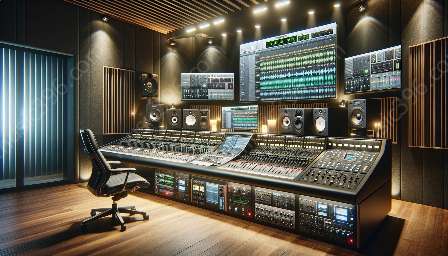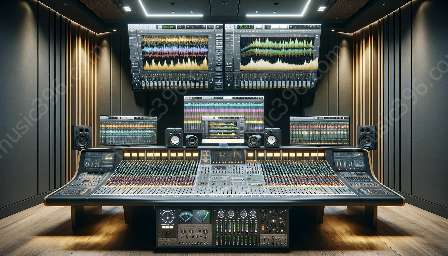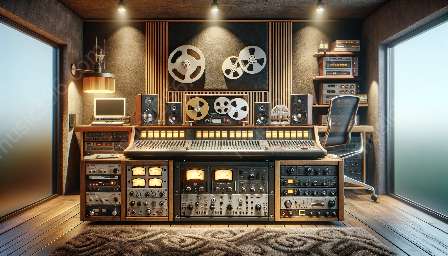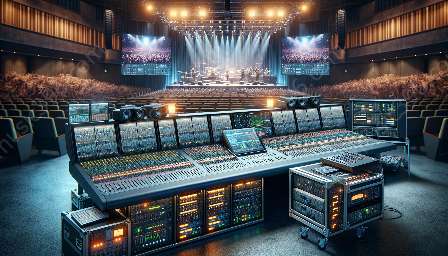In the world of audio production, dynamic processing plays a critical role in shaping the final sound of a music or audio project. It involves controlling the dynamic range of audio signals to create a balanced, professional sound. In this topic cluster, we'll explore the concept of dynamic processing in mix and its application in music and audio production.
Understanding Dynamic Processing
Dynamic processing refers to the manipulation of the dynamic range of audio signals. The dynamic range is the difference between the loudest and quietest parts of a sound. By altering this range, dynamic processing techniques can help achieve a more consistent and polished sound.
Types of Dynamic Processing:
- Compression: Compression is a widely used dynamic processing tool that reduces the dynamic range of audio signals. It controls the peaks of the sound, making the quieter parts more audible and the overall sound more even.
- Expansion: Expansion, on the other hand, increases the dynamic range of audio signals by boosting the quieter parts. This can be used to add more depth and dynamics to a sound.
- Gating: Gating is a process that mutes a signal until it reaches a certain threshold level. It can be effective in removing unwanted noise or enhancing the clarity of a sound.
Application in Audio Production
Dynamic processing is a fundamental part of the mixing stage in audio production. It allows engineers to sculpt the dynamics of individual tracks and the overall mix, ensuring that the music or audio project sounds cohesive and professional.
Benefits of Dynamic Processing in Mix:
- Balancing Levels: It helps maintain a consistent volume level throughout the track, avoiding abrupt changes in dynamics.
- Enhancing Transients: Dynamic processing can emphasize the initial impact of a sound, such as the attack of a drum hit or the strum of a guitar.
- Controlling Dynamics: It allows for precise control over the dynamics of individual instruments, vocals, or the entire mix.
- Creating Depth: By manipulating the dynamic range, dynamic processing can add depth and dimension to the sound, contributing to a more engaging listening experience.
Practical Techniques
When applying dynamic processing in mix, engineers have a wide array of tools and techniques at their disposal. From using specific compressor settings to understanding the nuances of multiband compression, mastering dynamic processing requires both technical knowledge and artistic sensibility.
Common Techniques:
- Threshold and Ratio Adjustment: Setting the threshold and ratio parameters on a compressor is crucial for achieving the desired amount of dynamic control.
- Parallel Compression: This technique involves blending a heavily compressed signal with the dry signal to achieve a balance between dynamics and punch.
- Sidechain Compression: By using a separate source to trigger the compressor, sidechain compression can be employed to create rhythmic pumping effects or to make space for certain elements in the mix.
Conclusion
Dynamic processing in mix is a multifaceted and essential aspect of audio production. Understanding the principles of dynamic range manipulation and using the right tools and techniques can significantly impact the overall quality of a music or audio project. By harnessing the power of dynamic processing, engineers can achieve a professional, balanced sound that captivates listeners and stands out in today's competitive music and audio landscape.
Topic
Frequency Modulation Synthesis and Sound Generation
View details
Audio Software Plugins and Creative Enhancement
View details
Digital Audio Processing in Live Sound Engineering
View details
Noise Reduction Techniques for Audio Restoration
View details
Spatial Audio Processing for Immersive Environments
View details
Real-Time Audio Processing in Multimedia Installations
View details
Questions
What are the key components of a digital audio workstation (DAW) and how do they function together?
View details
Explain the concept of signal flow in audio production and its significance in achieving high-quality sound.
View details
How do different types of microphones (dynamic, condenser, ribbon) impact the recording process in audio production?
View details
Discuss the principles of mixing audio tracks and the techniques used to achieve a balanced and polished sound.
View details
Examine the role of equalization and its impact on shaping the tonal characteristics of audio recordings.
View details
What are the fundamentals of dynamic range compression and its application in audio production?
View details
Describe the concept of reverb and its various applications in creating spatial and atmospheric effects in music production.
View details
Explain the process of sound synthesis and its relevance to creating unique and distinctive audio textures.
View details
How does the mastering process contribute to the final polish and cohesiveness of a music album?
View details
Discuss the principles of audio signal processing and the various types of audio effects used in modern music production.
View details
Examine the integration of MIDI (Musical Instrument Digital Interface) in music production and its impact on creative expression and performance.
View details
What are the key considerations when setting up a home studio for audio recording and production?
View details
Explain the concept of latency in digital audio processing and its implications for real-time monitoring and playback.
View details
Discuss the principles of sound design and its applications in creating immersive audio experiences for visual media.
View details
How does psychoacoustics influence the perception of sound and its implications for audio engineering and production?
View details
Examine the advancements in surround sound technology and its integration in music and film production.
View details
Describe the process of sound editing and its role in refining and shaping audio recordings for professional use.
View details
Discuss the principles of acoustics and their relevance to creating optimal listening environments for recording and mixing.
View details
Explain the concept of frequency modulation synthesis and its use in creating complex and evolving sounds.
View details
What are the key techniques for recording and processing vocals to achieve a professional and polished sound?
View details
Examine the role of audio processing software plugins in enhancing the creative and technical aspects of music production.
View details
Discuss the principles of dynamic processing and its role in controlling the level and dynamics of audio signals.
View details
How does the concept of phase coherence impact the quality and integrity of audio recordings and mixes?
View details
Explain the principles of binaural recording and its ability to capture immersive and spatial audio experiences.
View details
Examine the integration of field recording techniques in capturing natural soundscapes for use in music and audio production.
View details
Discuss the principles of sound reinforcement and its applications in live music performances and events.
View details
What are the key considerations for integrating digital audio processing in live sound engineering and concert production?
View details
Explain the concept of noise reduction and its techniques for minimizing unwanted noise in audio recordings.
View details
Discuss the principles of audio restoration and the methods used to recover and improve the quality of archival audio recordings.
View details
Examine the role of automation in audio production and its ability to streamline repetitive tasks and enhance creative workflows.
View details
Describe the principles of spatial audio processing and its applications in creating immersive and interactive sound environments.
View details
Discuss the integration of real-time audio processing in interactive multimedia installations and virtual reality experiences.
View details
Explain the concepts of audio analysis and visualization tools and their significance in understanding and manipulating audio data.
View details




























